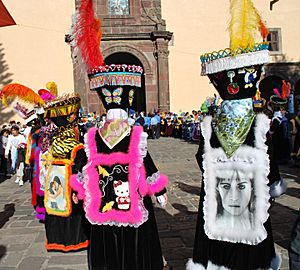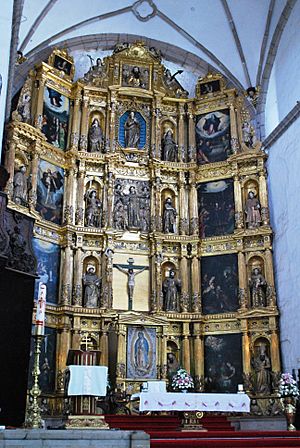San Bernardino de Siena Church, Xochimilco facts for kids
The San Bernardino de Siena Church is a very old and important church in Xochimilco, a part of Mexico City. It was built a long time ago, in the 1500s. This was right after the Spanish arrived in Mexico. The church was built on the spot where an ancient temple used to be.
Since it was built, the church has been a central place for Xochimilco's history and community life. Many special events happen here. One famous event involves a special statue of the Child Jesus called the Niñopa. Inside the church, there is a unique main altar from the 1500s. It's special because it doesn't have big columns like most altars. There's only one other altar like it in Mexico, found in a place called Huejotzingo.
Contents
A Look Back: The Church's History
When the Spanish first arrived, Xochimilco was connected to the Aztec capital, Tenochtitlan. Xochimilco even fought alongside the Aztecs against the Spanish. In 1521, Hernán Cortés attacked Xochimilco. This happened just before he attacked Tenochtitlan. Not many people survived this battle.
Building a New Faith Center
After the Aztec Empire fell, Spanish missionaries quickly began teaching Christianity. The last ruler of Xochimilco, Apochquiyauhtzin, became Christian in 1522. He was given the name Luís Cortés Cerón de Alvarado. This allowed him to stay as ruler. In 1524, a monk named Martín de Valencia started a big effort to teach Christianity to everyone. Other monks joined him in this important work.
At first, a small church was built where the old temple stood. But Xochimilco was a very important town in the south of the Valley of Mexico. So, in 1535, they started building a much bigger church. A monk named Francisco de Soto led this huge project. They also built smaller churches nearby and a hospital.
The church and its monastery were built in different stages. This construction lasted from 1535 to 1600. The monastery part was finished by 1538. By 1585, the main church was ready. More rooms for the monks were also added. The cloister, which is an open courtyard, was finished in 1604. Most of the money for building came from the local leaders of Xochimilco. Martín Cerón de Álvaro gave the most money.
The Church's Role in Community Life
Since it was built, the church has been at the heart of Xochimilco's life. It helped bring the community together and shaped their identity. In 1538, the Franciscans decided to remove the few monks from the church. This was because there weren't many monks left. But the local people protested, and two monks were allowed to stay.
In 1552, a part of the main entrance fell down. It was rebuilt and finished in 1590. By 1569, four monks were teaching Christianity to about 5,000 local people. Friar Jerónimo de Mendieta was in charge. By 1585, the number of monks grew to six. A school was started at the monastery in 1609. It taught subjects like public speaking, religion, and art.
The church was also responsible for many other communities. These included places like Santiago Tepalcatlalpan and San Miguel Topilejo. These areas are now part of Xochimilco and Tlalpan. As people became Christian, they were allowed to mix some of their old traditions with Catholic customs.
The Niñopa Tradition
The most famous tradition linked to the church is about the Niñopa. This is a statue of the Child Jesus from the 1500s. Missionaries encouraged these child statues. They wanted them to replace the worship of a child god that was common in Xochimilco. Today, a different family takes care of the Niñopa statue each year. The statue moves to a new home on February 2nd. This important yearly event for Xochimilco happens at this church.
In 1932, the church and its old monastery were declared a national monument. This means they are very important historical sites. In the 1960s, the church and monastery had big restoration work. This included fixing the buildings, paintings, altars, and statues. Some parts of the large church grounds were also used for other things. Two primary schools were on the property until the 1970s.
Exploring the Church: What It Looks Like
The San Bernardino Church is in the historic center of Xochimilco. It is right across from the main town square and the borough hall. The church faces east. The cloister is on the south side. This helps protect it from strong winds. In front of the church is a very large open area called an atrium. Big atriums were common for churches built in Mexico in the 1500s.
Outside the Church
The main front of the church looks simple. It highlights the main entrance. This entrance has an arch with two flat columns on the sides. Above the arch is a window for the choir. At the very top of the front are decorative shapes called merlons. These were originally built for defense. There is also a clock from the 1800s and a small bell tower. The main tower was built in 1716, and the clock was added in 1872.
The church first had a wooden roof. Later, this was changed to arched stone ceilings called vaults. The dome on top was finished in 1700. The side entrance of the church mixes different styles. It has elements from the Plateresque and Gothic styles. It also includes some local Mexican designs.
Next to the main entrance, there are three arches of an open chapel. These arches represent the three groups of people in the area: indigenous, Spanish, and mixed-race (mestizo). This was where baptisms often took place. This area leads to the old monastery cloister. The upper part of the cloister still has pieces of old wall paintings called frescos. These are from the colonial period.
There is also a small chapel called the Capilla de la Tercera Orden. It is just outside the cloister. This chapel has only one long room, built in four parts in the 1600s. Its main entrance is small and looks similar to the main church. This chapel used to be a place for the Holy Sacrament.
Inside the Church: The Main Altar
Inside, the most important piece of furniture is the main altarpiece from the 1500s. It is one of the few left in Mexico. It is in the Plateresque style, which was popular during the Renaissance. What makes it special is that it doesn't have columns or other clear supports. The only other altar like it is in Huejotzingo.
The altarpiece is made of many frames and spaces called niches. These are covered in shiny gold leaf. On one side of the altar, on the second level, there is a painting of Christ. This painting is from the 1500s but is not complete. On the other side of the same level, there is a painting of the Holy Family. This was painted in the 1600s or 1700s.
From the same time, there is a painting of the Most Pure Virgin on the third level. However, it is not in its original spot. On the fourth level, there is another painting of Christ from the 1500s or 1600s. A fifth level has another Christ painting from the 1600s. Our Lady of Mount Carmen is also on the fifth level, painted in the 1600s. The Martyrdom of Saint Peter is on the sixth level, painted in the 1600s or 1700s.
Also on the sixth level, there is a painting of the Passion from the 1600s. But it is in poor condition. An image of Saint Sebastian from the 1600s is on the seventh level.
The image of Saint Sebastian is placed with a statue of the Apostle James the Great. This is because in the late 1500s, Xochimilco had a terrible sickness called cocoliztli. It lasted for over a year. People believed that prayers to these two saints helped the sickness finally disappear. Among the many statues on this main altar, there is a carving of Bernardino of Siena. Around him are sculptures of the local leaders who helped build the church and monastery.
Art and Furniture
Throughout the church and monastery, there are many paintings and frescos. Some of these were made by famous artists. On the columns of the main part of the church, there are frescos of the Twelve Apostles.
The nicer benches, called pews, are made of red cedar wood. The two pulpits, where sermons are given, are also made of this wood. A carpenter named Juan Rojas made all of these in the 1700s.
See also
 In Spanish: Catedral de Xochimilco para niños
In Spanish: Catedral de Xochimilco para niños




